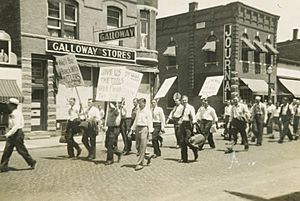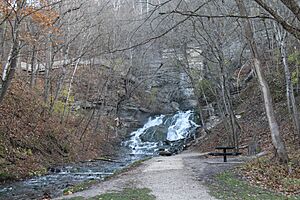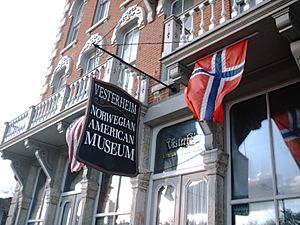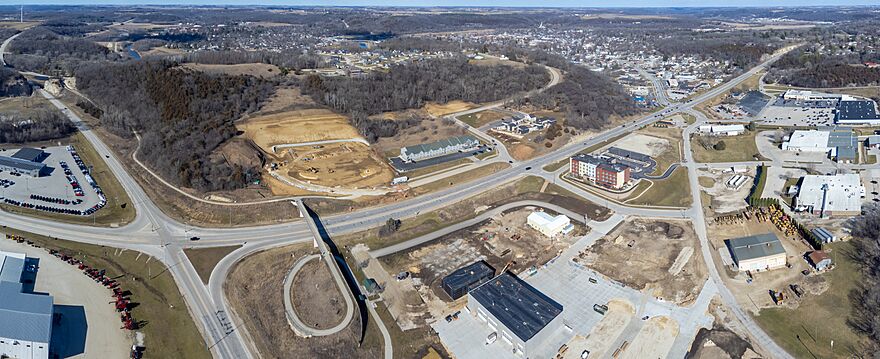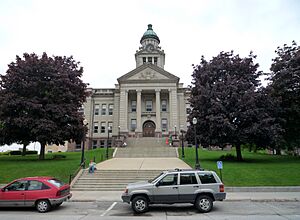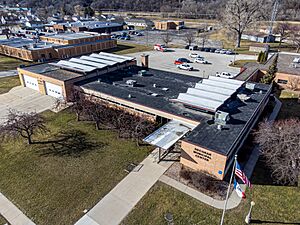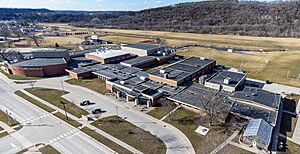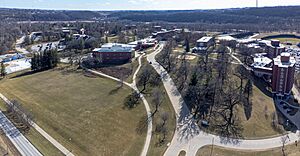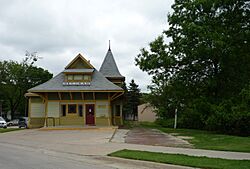Decorah, Iowa facts for kids
Quick facts for kids
Decorah, Iowa
|
|
|---|---|
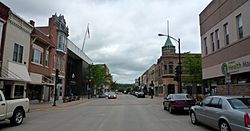
Downtown Decorah
|
|
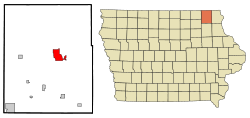
Location of Decorah, Iowa
|
|
| Country | |
| State | |
| County | Winneshiek |
| Incorporated | June 30, 1857 |
| Area | |
| • Total | 7.26 sq mi (18.80 km2) |
| • Land | 7.21 sq mi (18.68 km2) |
| • Water | 0.04 sq mi (0.11 km2) |
| Elevation | 869 ft (265 m) |
| Population
(2020)
|
|
| • Total | 7,587 |
| • Density | 1,051.71/sq mi (406.08/km2) |
| Time zone | UTC-6 (Central (CST)) |
| • Summer (DST) | UTC-5 (CDT) |
| ZIP code |
52101
|
| Area code(s) | 563 |
| FIPS code | 19-19405 |
| GNIS feature ID | 2394483 |
Decorah is the biggest city and the main town of Winneshiek County, Iowa, in the United States. In 2020, about 7,587 people lived there. Decorah is found where two main roads, State Highway 9 and U.S. Route 52, meet.
The city is in a special area called the Driftless Area in northeastern Iowa. This means it has hills and valleys, unlike much of Iowa. Decorah is nestled among the bluffs of the Upper Iowa River, which flows right through the city. It's also a college town, home to Luther College. Decorah is famous for its strong Norwegian-American history and the Vesterheim Norwegian-American Museum.
Contents
History of Decorah
Decorah was once home to a Ho-Chunk village around 1840. The U.S. Army had made them move from Wisconsin to this area. In 1848, the Ho-Chunks were moved again to Minnesota. This opened up their villages in Iowa for new settlers.
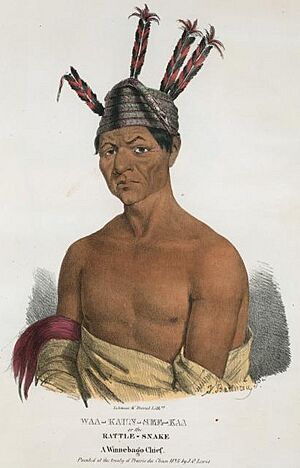
The first European-American settlers were the Day family from Tazewell County, Virginia. They arrived in June 1849. A local minister, Rev. Ephraim Adams, said that when the Days arrived, the Ho-Chunks' tents were still there. Even graves were scattered where the streets and houses of Decorah now stand. Judge Eliphalet Price suggested naming the new settlement Decorah. This was to honor Ho-Chunk leader Waukon Decorah, who was an ally of the U.S. during the Black Hawk War in 1832.
During the 1850s and 1860s, Decorah grew quickly. Settlers built dams and mills to use the water power from Dunning's Spring and other streams. In 1851, Decorah became the main town for Winneshiek County. From 1855 to 1856, it was also a place where immigrants could get land patents (official papers for land) in northern Iowa.
Since 1861, Decorah has been the home of Luther College. This is a liberal arts school linked to the Evangelical Lutheran Church in America.
The Milwaukee and St. Paul Railroad built a train line to Decorah in 1869.
Decorah has become a hub for Norwegian-American culture. Many Norwegian settlers came here starting in the 1850s. Every July, Decorah hosts Nordic Fest. This is a big celebration of Norwegian culture with dancing, food, and music. Decorah is also home to the Vesterheim Norwegian-American Museum. This is the largest museum in the U.S. dedicated to one immigrant group. Until 1972, a major Norwegian language newspaper, the Decorah Posten, was published here.
Geography and Unique Features
Decorah is about 15 miles (24 km) south of the Minnesota-Iowa border. It's the biggest town along U.S. Route 52 in Iowa in the northern part of the state. The city covers about 7.04 square miles (18.23 km²), with most of it being land. Decorah is located in the bluffs of the Upper Iowa River valley. The river flows through the city on its way to the Upper Mississippi River. The area has steep bluffs, which are typical of the Driftless Area.
Decorah's Hidden Crater
About 470 million years ago, a huge meteorite, as big as a city block, crashed into what is now Decorah. This supports a theory that a giant space rock broke apart and hit Earth. This happened when early life was just starting to grow in the oceans.
The impact created a crater almost four miles wide. This crater now lies hidden beneath the town. It was only discovered recently because almost none of it is visible above ground. Instead, it is filled with a special type of rock called shale. This shale formed after an ancient sea flowed into the crater. It left behind mud and many strange sea creatures that turned into fossils. One of these creatures is Pentecopterus decorahensis, which was named after the city.
Climate in Decorah
| Climate data for Decorah, Iowa (1991–2020 normals, extremes 1893–present) | |||||||||||||
|---|---|---|---|---|---|---|---|---|---|---|---|---|---|
| Month | Jan | Feb | Mar | Apr | May | Jun | Jul | Aug | Sep | Oct | Nov | Dec | Year |
| Record high °F (°C) | 60 (16) |
79 (26) |
94 (34) |
93 (34) |
102 (39) |
110 (43) |
111 (44) |
105 (41) |
100 (38) |
94 (34) |
79 (26) |
78 (26) |
111 (44) |
| Mean maximum °F (°C) | 45.4 (7.4) |
49.6 (9.8) |
67.2 (19.6) |
80.3 (26.8) |
87.2 (30.7) |
91.5 (33.1) |
92.2 (33.4) |
90.8 (32.7) |
88.3 (31.3) |
81.6 (27.6) |
64.8 (18.2) |
49.2 (9.6) |
94.0 (34.4) |
| Mean daily maximum °F (°C) | 27.7 (−2.4) |
32.8 (0.4) |
46.2 (7.9) |
61.3 (16.3) |
72.5 (22.5) |
81.4 (27.4) |
84.4 (29.1) |
82.7 (28.2) |
76.4 (24.7) |
63.2 (17.3) |
46.6 (8.1) |
32.9 (0.5) |
59.0 (15.0) |
| Daily mean °F (°C) | 19.0 (−7.2) |
23.4 (−4.8) |
36.0 (2.2) |
49.3 (9.6) |
60.5 (15.8) |
70.0 (21.1) |
73.5 (23.1) |
71.7 (22.1) |
64.4 (18.0) |
51.8 (11.0) |
37.5 (3.1) |
25.2 (−3.8) |
48.5 (9.2) |
| Mean daily minimum °F (°C) | 10.4 (−12.0) |
14.0 (−10.0) |
25.9 (−3.4) |
37.3 (2.9) |
48.4 (9.1) |
58.6 (14.8) |
62.6 (17.0) |
60.7 (15.9) |
52.3 (11.3) |
40.4 (4.7) |
28.4 (−2.0) |
17.4 (−8.1) |
38.0 (3.3) |
| Mean minimum °F (°C) | −18.2 (−27.9) |
−12.3 (−24.6) |
0.3 (−17.6) |
19.7 (−6.8) |
30.2 (−1.0) |
42.3 (5.7) |
48.8 (9.3) |
46.8 (8.2) |
34.0 (1.1) |
21.8 (−5.7) |
8.3 (−13.2) |
−8.4 (−22.4) |
−22.2 (−30.1) |
| Record low °F (°C) | −53 (−47) |
−45 (−43) |
−36 (−38) |
−15 (−26) |
23 (−5) |
31 (−1) |
36 (2) |
33 (1) |
−7 (−22) |
−21 (−29) |
−35 (−37) |
−44 (−42) |
−53 (−47) |
| Average precipitation inches (mm) | 1.01 (26) |
1.10 (28) |
2.05 (52) |
3.95 (100) |
4.94 (125) |
6.13 (156) |
4.42 (112) |
4.39 (112) |
3.60 (91) |
2.66 (68) |
2.05 (52) |
1.31 (33) |
37.61 (955) |
| Average snowfall inches (cm) | 10.3 (26) |
8.3 (21) |
5.7 (14) |
1.7 (4.3) |
0.0 (0.0) |
0.0 (0.0) |
0.0 (0.0) |
0.0 (0.0) |
0.0 (0.0) |
0.0 (0.0) |
2.4 (6.1) |
9.1 (23) |
37.5 (95) |
| Average precipitation days (≥ 0.01 in) | 7.5 | 6.2 | 8.0 | 12.0 | 13.4 | 12.2 | 9.9 | 10.0 | 9.3 | 9.4 | 7.6 | 8.4 | 113.9 |
| Average snowy days (≥ 0.1 in) | 6.2 | 5.2 | 2.8 | 1.0 | 0.0 | 0.0 | 0.0 | 0.0 | 0.0 | 0.0 | 1.9 | 6.2 | 23.3 |
| Source: NOAA | |||||||||||||
People of Decorah
| Historical population | ||
|---|---|---|
| Year | Pop. | ±% |
| 1860 | 1,920 | — |
| 1870 | 2,110 | +9.9% |
| 1880 | 2,951 | +39.9% |
| 1890 | 2,801 | −5.1% |
| 1900 | 3,246 | +15.9% |
| 1910 | 3,592 | +10.7% |
| 1920 | 4,039 | +12.4% |
| 1930 | 4,581 | +13.4% |
| 1940 | 5,303 | +15.8% |
| 1950 | 6,060 | +14.3% |
| 1960 | 6,435 | +6.2% |
| 1970 | 7,237 | +12.5% |
| 1980 | 8,068 | +11.5% |
| 1990 | 8,063 | −0.1% |
| 2000 | 8,172 | +1.4% |
| 2010 | 8,127 | −0.6% |
| 2020 | 7,587 | −6.6% |
| Source: Source: |
||
How Many People Live Here?
In 2020, the population of Decorah was 7,587 people. The city had about 1,052 people per square mile. There were 3,210 homes. Most people living in Decorah (91.7%) were White. Other groups included Asian (1.8%), Black or African American (1.4%), and Native American (0.3%). About 3.6% of the population were Hispanic or Latino.
The 2020 census count included 1,463 students living in college housing.
The average income for a household in Decorah was $55,920. For families, it was $85,822. About 10% of the population lived below the poverty line. This included 11% of those under 18. Most adults (96.9%) had finished high school. Also, 43.8% had a bachelor's degree or higher.
A Look at 2010
In 2010, Decorah had 8,127 people. The average age was 29.6 years. About 14.3% of residents were under 18. A large group, 32.1%, were between 18 and 24 years old. This shows the impact of the college in town.
Economy and Jobs
Decorah is the main town for Winneshiek County. This means the county government is a big employer here. The county courthouse was built in 1903. The largest employer in Decorah is Luther College. There are also several national companies. Since farming is very important in Winneshiek County, Decorah serves as a center for agriculture. Decorah is also home to Seed Savers Exchange. This group works to save and grow old types of plants.
Fun Things to Do
Every July, Decorah hosts Nordic Fest. This is a big celebration of Norwegian culture. Decorah is also home to the Vesterheim Norwegian-American Museum. This is the largest Norwegian museum in the United States.
You can visit natural spots like Dunning's Spring, the Ice Cave, and Siewers Spring. The city has several parks on bluffs, like Phelps Park, Palisades Park, and Pulpit Rock.
Decorah has a working trout hatchery. You can also visit Twin Springs Park, which used to be the hatchery's home.
The Raptor Resource Project is in Decorah. Each year, they have a livestreamed webcam of a family of nesting bald eagles. You can watch the eagles raise their young!
Schools and Learning
Decorah is part of the Decorah Community School District. The high school is Decorah High School, and their team mascot is the Vikings.
St. Benedict School is a Catholic school in Decorah. It opened in 1885. The current school building was built in 1964.
Decorah is also home to Luther College. This is a private four-year college. It is known for its Nordic Choir. The college's mascot is "The Norse."
Local News and Radio
Newspapers: Decorah has two community newspapers printed twice a week: The Driftless Journal and Decorah Public Opinion. Their office is at 110 Washington Street, Decorah, IA 52101.
Online News: You can find local independent news on the Decorah News website.
Radio Stations in Decorah
- KLNI 88.7 (Minnesota Public Radio News)
- KPVL 89.1 (Studios in both Postville and Decorah)
- KLCD 89.5 (Classical Minnesota Public Radio)
- K247BF-LP 97.3 (Translator for KWVI)
- K257CI-LP 99.3 (Translator for KQYB-FM)
- KDHK 100.5 "Hawk Rawk"
- K268AF-LP 101.5 (Translator for KFSI)
- KVIK 104.7 "The Viking"
- KDEC 1240
- KWLC 1240 (Luther College)
Famous People from Decorah
Many notable people have connections to Decorah, including:
- William Foege, an expert on diseases.
- Josey Jewell, an NFL linebacker for the Carolina Panthers.
- Raef LaFrentz, a former NBA power forward.
- Weston Noble, a famous music teacher.
- Rob Sand, who is the Iowa State Auditor.
- Oswald Veblen, a well-known mathematician.
Images for kids
See also
 In Spanish: Decorah (Iowa) para niños
In Spanish: Decorah (Iowa) para niños


